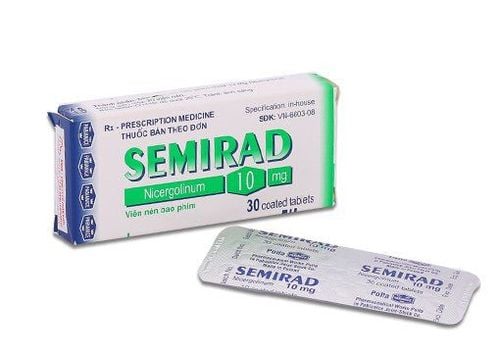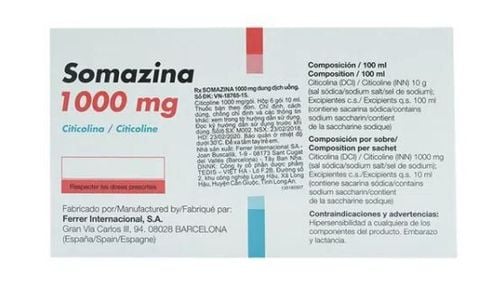This is an automatically translated article.
The article was written by Doctor Vu Duy Dung - Department of General Internal Medicine - Vinmec Times City International General Hospital.Ischemic stroke in infants and children can occur because of arterial occlusion (cerebrovascular ischemic stroke) or venous occlusion (venous sinus thrombosis). Brain). Rapid diagnosis and early treatment are needed to minimize complications and limit brain damage, including preventing stroke from spreading and recurring.
1.Clinical Manifestations Perinatal ischemic stroke, estimated to occur in 1/2500 infants, is defined as having pathologic or radiologic evidence of arterial ischemic infarction or varicose veins occur between 20 weeks of pregnancy and 28 days of age.
Perinatal stroke can be diagnosed at birth, the most typical manifestation of an infant with acute middle cerebral artery stroke is recurrent seizures within the first few days of life.
Infants (aged 1 month to 1 year) with perinatal ischemic stroke during the first year of life often have symptoms such as: hemiplegia, developmental delay, or seizures.
The vascular distribution of perinatal ischemic stroke can be either arterial or venous. Arterial distribution is more common in infants, while venous infarction involving the periventricular region occurs earlier in utero and is more common in premature infants.
2. Causes of ischemic stroke in the perinatal period Risk factors for perinatal ischemic stroke often focus on perinatal arterial stroke, especially those with acute presentation. calculated in the neonatal period; However, the conclusions are limited.
3. Diagnosis of ischemic stroke in the perinatal period Cranial ultrasound: As the method of choice for periventricular hemorrhage in preterm infants, cranial ultrasound has low sensitivity to stroke. Perinatal ischemic stroke in term infants. Cranial CT: More sensitive than cranial ultrasound but requires irradiation and should only be used if other methods are not available. Cranial MRI : DWI pulse is considered the most sensitive to help identify perinatal cerebral artery ischemic stroke and should be performed as soon as possible Thrombotic test: Routine thrombosis test in dynamic stroke Perinatal cerebral vascularization helps assess thrombosis but cannot alter treatment. Thrombotic testing is indicated for those with a history of maternal autoimmune disease, thrombosis, or recurrent miscarriage. Echocardiography is indicated if congenital heart disease or thrombosis from the heart is suspected.

4.Emergency treatment of perinatal ischemic stroke In acute symptomatic perinatal arterial stroke presenting with seizures, electroencephalography (EEG), including EEG continuous, can be used to evaluate the effectiveness of antiepileptic drugs. Use of anticoagulants or aspirin is not recommended if an existing cardiac source of thrombosis cannot be found. Pre-feeding assessment is important, and close neurodevelopmental monitoring is required upon discharge.
5. Consequences of ischemic stroke in the perinatal period Infants with perinatal stroke are at increased risk for epilepsy, including refractory epilepsy and infantile spasms.
The majority of infants with perinatal cerebral artery stroke will lead to neuro-cognitive consequences that delay the child's development. Neuro-motor consequences make children hemiplegic.
If the newborn has signs of ischemic stroke, parents should not subjectively need to take the child to a reputable medical facility for stroke screening. Currently, Magnetic Resonance Imaging - MRI/MRA is considered a "golden" tool to screen for brain stroke. MRI is used to check the condition of most organs in the body, especially valuable in detailed imaging of the brain or spinal nerves. Due to the good contrast and resolution, MRI images allow to detect abnormalities hidden behind bone layers that are difficult to recognize with other imaging methods. In particular, the process of scanning with MRI does not cause side effects like in X-rays or computed tomography (CT).
Vinmec International General Hospital currently owns a 3.0 Tesla MRI System, which is equipped with state-of-the-art equipment by GE Healthcare (USA) with high image quality, allowing for a comprehensive assessment, without omitting the injury without leaving any damage. and reduce shooting time. Silent technology reduces noise, improves image quality and shortens the time taken. With the state-of-the-art MRI system and the application of modern cerebral vascular intervention methods, the team of specialists Experienced and well-trained neurologist and radiologist, Vinmec is a reputable and trusted place to examine and screen for stroke risk.
Please dial HOTLINE for more information or register for an appointment HERE. Download MyVinmec app to make appointments faster and to manage your bookings easily.














